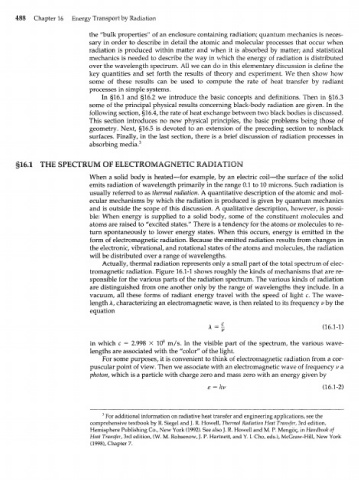Page 508 - Bird R.B. Transport phenomena
P. 508
488 Chapter 16 Energy Transport by Radiation
the "bulk properties" of an enclosure containing radiation; quantum mechanics is neces-
sary in order to describe in detail the atomic and molecular processes that occur when
radiation is produced within matter and when it is absorbed by matter; and statistical
mechanics is needed to describe the way in which the energy of radiation is distributed
over the wavelength spectrum. All we can do in this elementary discussion is define the
key quantities and set forth the results of theory and experiment. We then show how
some of these results can be used to compute the rate of heat transfer by radiant
processes in simple systems.
In §16.1 and §16.2 we introduce the basic concepts and definitions. Then in §16.3
some of the principal physical results concerning black-body radiation are given. In the
following section, §16.4, the rate of heat exchange between two black bodies is discussed.
This section introduces no new physical principles, the basic problems being those of
geometry. Next, §16.5 is devoted to an extension of the preceding section to nonblack
surfaces. Finally, in the last section, there is a brief discussion of radiation processes in
absorbing media. 3
§16.1 THE SPECTRUM OF ELECTROMAGNETIC RADIATION
When a solid body is heated—for example, by an electric coil—the surface of the solid
emits radiation of wavelength primarily in the range 0.1 to 10 microns. Such radiation is
usually referred to as thermal radiation. A quantitative description of the atomic and mol-
ecular mechanisms by which the radiation is produced is given by quantum mechanics
and is outside the scope of this discussion. A qualitative description, however, is possi-
ble: When energy is supplied to a solid body, some of the constituent molecules and
atoms are raised to "excited states/' There is a tendency for the atoms or molecules to re-
turn spontaneously to lower energy states. When this occurs, energy is emitted in the
form of electromagnetic radiation. Because the emitted radiation results from changes in
the electronic, vibrational, and rotational states of the atoms and molecules, the radiation
will be distributed over a range of wavelengths.
Actually, thermal radiation represents only a small part of the total spectrum of elec-
tromagnetic radiation. Figure 16.1-1 shows roughly the kinds of mechanisms that are re-
sponsible for the various parts of the radiation spectrum. The various kinds of radiation
are distinguished from one another only by the range of wavelengths they include. In a
vacuum, all these forms of radiant energy travel with the speed of light c. The wave-
length Л, characterizing an electromagnetic wave, is then related to its frequency v by the
equation
A = % (16.1-1)
in which с = 2.998 X 10 8 m/s. In the visible part of the spectrum, the various wave-
lengths are associated with the "color" of the light.
For some purposes, it is convenient to think of electromagnetic radiation from a cor-
puscular point of view. Then we associate with an electromagnetic wave of frequency v a
iphoton, which is a particle with charge zero and mass zero with an energy given by
e = hv (16.1-2)
3 For additional information on radiative heat transfer and engineering applications, see the
comprehensive textbook by R. Siegel and J. R. Howell, Thermal Radiation Heat Transfer, 3rd edition,
Hemisphere Publishing Co., New York (1992). See also J. R. Howell and M. P. Mengoc,, in Handbook of
Heat Transfer, 3rd edition, (W. M. Rohsenow, J. P. Hartnett, and Y. I. Cho, eds.), McGraw-Hill, New York
(1998), Chapter 7.

